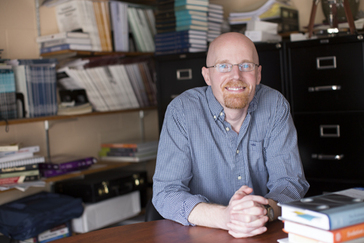Professor chooses to ‘teach into the void’ for his students

Photo Courtesy of Virgil Zeigler-Hill
Virgil Zeigler-Hill sits at his desk at Oakland University. He has a doctorate in psychology and specializes in interpersonal relationships.
Choosing the “camera on” function in virtual classroom communication is becoming an “ethical problem,” according to Virgil Zeigler-Hill, Ph.D.
To inch closer to in-person class, many professors are encouraging or requiring students to turn their cameras on during class. Additionally, some classes factor camera’s into its participation grades.
Cameras help professors elude “teaching into the void,” and Zeigler-Hill “sympathizes” with other professors facing blank screens. Even so, he doesn’t require students to turn their cameras on in his class.
“Personally, I side with letting students make the decision that best for their particular set of circumstances,” he said.
Although he usually doesn’t see his students, engagement is still possible. Forming a connection beyond just lecturing at a screen is difficult, but if the students are “invested” then they will still form connections with the material, according to Zeigler-Hill, who earned his Ph.D. in psychology.
“The lectures tend to be much richer and dynamic when students are really invested and asking good questions,” Zeigler-Hill said.
Ultimately, many students are not choosing to take online courses, this is just what’s available right now. Despite shifting some courses in person, roughly 65% of class at OU is still conducted online.
“I think the current situation is certainly not a perfect one … If students don’t feel comfortable turning their cameras on for whatever reason, I think we should respect that,” he said.
In the future if students choose online class, a camera requirement seems reasonable to Zeigler-Hill, but online class is the only option for many OU courses right now.
Learning at home can pose an array of distractions: roommates, family, household chores, chat rooms, social media, etc. Turning a camera on is another distraction for many classes that require cameras.
Depending on the video platform, many calls show your own camera view when it’s on.
Many people naturally don’t like seeing visuals of themselves, and the camera feature can turn into another distraction. People will often critique their appearance to perform for the camera.
“We don’t really want students overly focused on looking at their own image: thinking about their hairstyles, weight loss or whatever else may be going through people’s heads,” Zeigler-Hill said.
Aside from distractions, some students may not be comfortable showing their background on a classroom call.
Considering a background before starting class or using a virtual background could be a solution though, according to Fortune. Now, appearance and surroundings affect perception of classmates and instructors.
What makes students and instructors feel most at home in their make-shift classrooms at home is individualized. Zeigler-Hill understands “both sides of the [camera] argument,” but because camera preferences are individualized, he’s decided to put the control in his students’ hands.
“For the moment, in the current situation we all find ourselves in, we should be as flexible as possible for students,” Zeigler-Hill said. “The environment that they find themselves in is already particularly unpleasant for learning.”










